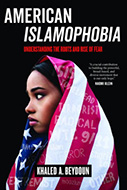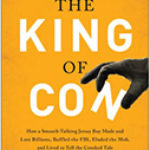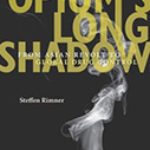American Islamophobia: Understanding The Roots And Rise Of Fear

Author: Khaled A. Beydoun
Publisher: Oakland, CA: University of California Press, 2018. 264p.
Reviewer: Stephen Sheehi | September 2020
Khaled Beydoun’s American Islamophobia: Understanding the Roots and Rise of Fear approaches Islamophobia through an “intersectional” approach, most notably anchored in how the “Muslim American narrative is actually rooted in blackness” (20). Approaching the topic as a legal scholar, Beydoun aims to offer a “new understanding of Islamophobia,” defining it “as the presumption that Islam is inherently violent, alien and unassimilable, a presumption driven by the belief that expressions of Muslim identity correlate with a propensity for terrorism” (28).
While this definition has been the prevailing definition of Islamophobia, and therefore quite the opposite from a “new understanding,” he maps “three dimensions” of Islamophobia. “Private Islamophobia” is “the fear, suspicion, and violent targeting of Muslims by private actors” (32). It is what is popularly understood as personal acts of anti-Muslim hate, as in the case of Craig Hick’s execution-style murder of three Muslim-American UNC students in 2015. “Structural Islamophobia” is the “fear and suspicion of Muslims as a part of government institutions and actors,” and expressed “through the enactment and advancement of laws, policy, and programming” predicated on the racist assumption that Muslims are an inherent threat (36). Most readily, this is demonstrated in the Patriot Act, the policies and, in fact, raison d’être of the Department of Homeland Security, let alone Trump’s “Muslim Ban.” Finally, “Dialectical Islamophobia” is “the process by which structural Islamophobia shapes, reshapes, and endorses views or attitudes about Islam and Muslim subjects inside and outside of America’s borders” (40). In other words, dialectical Islamophobia is the way in which structural Islamophobia gives license to, “authorizes and mobilizes private bigotry towards Muslims” (42).
Beydoun’s book asserts that “sixteen years after 9/11, `Islamophobia’ is a widely known and uttered term. Yet, the depth of its sources and the breadth of its victims are hardly understood, particularly where poverty, gender, legal status (or lack of it) and race intersect” (18). While Beydoun is clear in stating that the “book does not aim to provide a chronological and comprehensive history of Muslim Americans or of Islamophobia” (22), the aforementioned stated aim, ironically, discloses what is most lacking in the book. Indeed, Islamophobia can only be understood “intersectionally,” just as in the case of all racist discourses. Indeed, Arab and Muslim American scholars, artists and activists have critiqued exceptionalizing of their communities’ experience as one more form of perpetuating the myth of the “model minority,” whose currency disintegrates on September 11. Yet, rather than connect with the myriad of scholars, legal minds, artists, and activists whose work sustains critical and progressive Arab and Muslim American activism and, in fact, has built bridges and relationships with other marginalized communities in the United States (and abroad) for decades, Beydoun chooses to largely ignore them.
That is, Beydoun cites regrettably few of the now standard works on Islamophobia. He overlooks ground-breaking book-length studies on Islamophobia published in the decade after 9/11 by scholars such as Jasper Puar and Deepa Kumar, scholarship on Arab Americans by Louise Cainkar, Steven Salaita, Rabab Abdelhadi, Sherene Razack, and Nadine Naber (only cited in passing), and numerous more recent works that directly engage race, sexuality, gender, and class, including Janet Abu Lughod, Anne Norton, Sunera Thobani, Sohail Daulatzai, Junaid Rana, Sylvester Johnson, Ala Alryyes, John Esposito, Christopher Bail, Peter Gottschalk, and Todd Green and many more. While he seems interested in relating the personal narratives of Muslim-Americans, he fails to mention or interface with the Arab and Muslim American stories as offered by Arun Kundani, Moustafa Bayoumi and Omid Safi and Linda Cateura. This list itself leaves out so many, and is far from even a basic syllabus on Islamophobia. This is not even to mention the slew of powerful articles, largely around race, sexuality, class and gender, by scholars of color, such as Sylvia Chan-Malik, Nazia Kazi and Mejdulene B. Shomali, Nicole Nguyen, Sahar Soled, and Ronak Kapadia.
Unlike the scholarship of Wadie Said, Natsu Taylor Saito, and Sahar Aziz, (the latter two of whom I was happy to see mentioned in passing), the book offers, unfortunately only sparingly, legal cases and case-law, which are a major feature of many studies on Islamophobia in the United States, let alone those discussed by legal scholars. Most of the legal cases he presents have been discussed to some degree by a number of the aforementioned scholars.
For example, Beydoun affirms that Islamophobia emerged in tandem with anti-Black racism and Orientalism in the United States, noting the Muslim identity of the earliest slave populations in what he calls Antebellum Islam of the American slave-holding South. Chapter Two also presents historic legal vignettes regarding the naturalization hearings of Arab Americans in the first half of the twentieth century. These include the well-known case of immigrant and former Los Angeles police officer George Shishim in 1909, whose naturalization depended on his ability to argue that he, as an Arab Christian from Ottoman Syro-Lebanon, was white. Beydoun is absolutely correct (and not original) in marking the racialization of Arab and Muslim immigrants, a racialization in which the courts took a determinative role in adjudicating their relation to both whiteness and blackness.
Beydoun’s argumentation, in this case, represents however, the slippage and perhaps sloppiness that marks much of his work. Shishim was considered “not white” by the presiding judge not because he associated Arabs-as-Muslims, and therefore as black, as the author states. Rather, Beydoun shows himself that Arabs were not considered white because they were categorized as “Asiatic,” “Mongolian”, and/or “Mongoloid.” This is incredibly important for the history of the racialization of Arab-Americans, the race history of the US based on a racial hierarchy and particularly, the history of understanding Arab-Americans as a part of and in relation to the history of the racialization of Asian Americans as well. Histories of Arab Americans (exemplified by the work of Sarah Gualtieri) established that Arab Americans (even if Christian) were clearly associated with blackness for sure. But also, as Frye-Jacobson, Roediger, and Winnant and Omi show, Arab Americans willfully sought to enter whiteness by disassociating from Asian-ness, and as apart from blackness, especially in the Jim Crow South. Beydoun’s presentation of the cases of Maronite Faras Shahid, and Muslim immigrants Ahmed Hassan and Mohammed Mohriez, are a more convincing association of the non-whiteness of Muslims and Arabs in relation to blackness.
By building onto, critically engaging, and locating his analysis within the community of ideas, politics, activists, artists, and scholars that and who have studied Islamophobia, Beydoun could have opened up a space to contribute insights from his legal training. For example, presidential advisor Kellyanne Conway, herself an attorney, reminded us that the National Security and Entry and Exit Registration System (NSEERS) already existed, and therefore presented a policy precedent for Trump’s bold-faced targeting of Muslim immigrants. By deploying some of the scholarly rigor he demonstrates in some of his law review articles, Beydoun is well-positioned and very qualified to show us what NSEERS looked like under the Bush and Obama administrations and in the court room. How were they deployed? What were the judgements around them? This would have complimented the work of other scholars, who have carefully studied Muslim-American defendants’ cases regarding “material support” (of terrorism) charges, or what becomes of those Muslim-Americans targeted, profiled, and often set up by Counter-Violent Extremism (CVE) policies.
Similarly, the author’s revisit of Mamdani’s concept of “Bad Muslims/Good Muslims” could have been an opportunity to demonstrate how “dialectical Islamophobia” plays out, for example, in the defenses of Muslim-Americans prosecuted under federal terrorism changes. Or perhaps, considering his interest in the intersection between structural anti-Black racism and “structural Islamophobia” as bore out in in Chapter Six, he could have fleshed out in greater legal detail how Black American Muslims remain in the crosshairs of both federal and local law enforcement and the prison-industrial-complex’s “counter-radicalizations” programs. Perhaps, also, he could have unpacked the number of racial profiling cases, if not state-sanctioned murders of Black American Muslim activist voices in his own state of Michigan, such as Imam Luqman Abdullah, who was executed by the FBI. He also could have considered how state sanctioned Islamophobia works to keep Black American Muslim political prisoners incarcerated, from Jamil Abdullah Al-Amin (formerly known as H. Rap Brown), and Jalil Muntaqim to Kamau Sadiki (formerly known as Freddie Hilton) and Abdul Azeez and others from the “Virgin Island Five.”
Had Beydoun grounded his analysis, even if intended for a larger mainstream audience, in the panoply of diverse interdisciplinary and rigorous studies of Islamophobia’s many facets, pedigrees, and intersections, he would have been able to move beyond rather well-worn discussions of Orientalism, the “clash of civilizations,” media-representations, and the “war on terror” that contribute very little additional material and insight, whether historically, critically, substantially, or legally, to the topic. While American Islamophobia: Understanding the Roots and Rise of Fear offers little new material or analysis, the uninitiated may find it useful, as it is well-written, poignant and powerful at times, as well as engaging and current in its presentation of Islamophobia in the United States.
Stephen Sheehi, Sultan Qaboos Professor of Middle East Studies, William & Mary.


